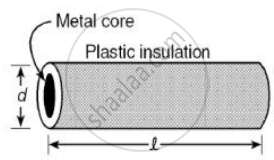Advertisements
Advertisements
प्रश्न

Plastic insulation surrounds a wire having diameter d and length l as shown above. A decrease in the resistance of the wire would be produced by an increase in the ______.
पर्याय
length l of the wire
diameter d of the wire
temperature of the wire
thickness of the plastic insulation
उत्तर
Plastic insulation surrounds a wire having diameter d and length l as shown above. A decrease in the resistance of the wire would be produced by an increase in the diameter d of the wire.
APPEARS IN
संबंधित प्रश्न
Use the data in the Table given below to answer the following –
Which among iron and mercury is a better conductor?
Table give below Electrical resistivity of some substances at 20°C
| Electrical resistivity of some substances at 20°C | ||
| − | Material | Resistivity (Ω m) |
| Conductors |
Silver | 1.60 × 10−8 |
| Copper | 1.62 × 10−8 | |
| Aluminium | 2.63 × 10−8 | |
| Tungsten | 5.20 × 10−8 | |
| Nickel | 6.84 × 10−8 | |
| Iron | 10.0 × 10−8 | |
| Chromium | 12.9 × 10−8 | |
| Mercury | 94.0 × 10−8 | |
| Manganese | 1.84 × 10−6 | |
| Alloys |
Constantan (alloy of Cu and Ni) |
49 × 10−6 |
| Manganin (alloy of Cu, Mn and Ni) |
44 × 10−6 | |
| Nichrome (alloy of Ni, Cr, Mn and Fe) |
100 × 10−6 | |
| Insulators | Glass | 1010 − 1014 |
| Hard rubber | 1013 − 1016 | |
| Ebonite | 1015 − 1017 | |
| Diamond | 1012 − 1013 | |
| Paper (dry) | 1012 | |
What is (a) the highest, (b) the lowest total resistance that can be secured by combinations of four coils of resistance 4 Ω, 8 Ω, 12 Ω, 24 Ω?
Two conducting wires of the same material and of equal lengths and equal diameters are first connected in series and then parallel in a circuit across the same potential difference. The ratio of heat produced in series and parallel combinations would be:
A copper wire has diameter 0.5 mm and resistivity of 1.6 × 10−8Ω m. What will be the length of this wire to make its resistance 10 Ω? How much does the resistance change if the diameter is doubled?
Why are copper and aluminium wires usually employed for electricity transmission?
Which has less electrical resistance : a thin wire or a thick wire (of the same length and same material)?
What is meant by the "resistance of a conductor" ? Write the relation between resistance, potential difference and current.
What happens to the resistance as the conductor is made thinner?
Name the electrical property of a material whose symbol is "omega".
Calculate the resistance of a copper wire 1.0 km long and 0.50 mm diameter if the resistivity of copper is 1.7 × 10−8 Ω m.
